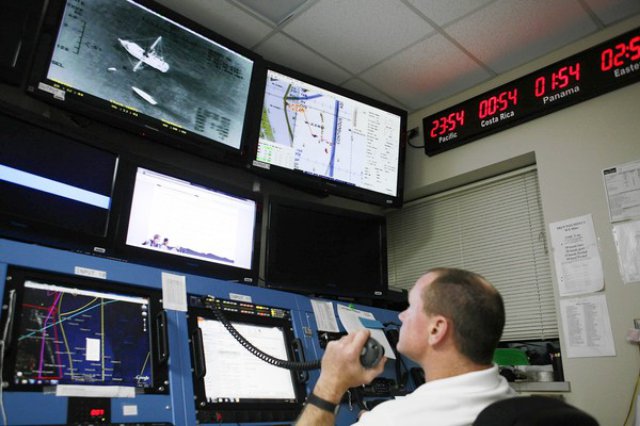Lyle Belew, Command Duty Officer in Predator Ops at the Naval Air Station in Corpus Christi, Texas, communicates with a Predator Pilot
The drug runners call it “el mosco,” the mosquito, and one recent evening on the southern tip of Texas, a Predator B armed with cameras buzzed softly over the beach on South Padre Island and headed inland.
“We’re going to get some bad guys tonight, I’ve got a feeling,” said Scott Peterson, a U.S. Customs and Border Protection supervisory air interdiction agent. He watched the aircraft’s live video feed in the Predator Ops room at Naval Air Station Corpus Christi, about 50 miles away.
As the unmanned plane flew up the winding Rio Grande, which forms the border with Mexico, Peterson fielded excited phone calls. One agent had seen known scouts for a Mexican cartel at a Dairy Queen, suggesting a load of drugs was coming through. Another called in the precise spot where the shipment would land.
Soon the drone’s infrared camera picked up a man hauling bales of marijuana from an inflatable rubber boat into a minivan on the Texas side of the river. Then it spotted a second boat. Agents readied for a major bust.
But the April 18 raid was not the success Peterson had envisioned. He wanted the aircraft to track the smugglers to a stash house, and perhaps to ranking cartel members. Instead, Border Patrol agents rushed to the riverbank, sirens blaring. They seized half a ton of pot, a 1996 Plymouth Voyager van and a boat. The smugglers escaped and no one was arrested.
The mixed results highlight a glaring problem for Homeland Security officials who have spent six years and more than $250 million building the nation’s largest fleet of domestic surveillance drones: The nine Predators that help police America’s borders have yet to prove very useful in stopping contraband or illegal immigrants.
The border UAS require an hour of maintenance for every hour they fly, cost more to operate than anticipated, and are frequently grounded by rain or other bad weather, according to a draft audit of the programme last month by the Homeland Security Department’s inspector general.
Last year, the unmanned fleet flew barely half the number of flight hours that Customs and Border Protection had scheduled on the northern or southern borders, or over the Caribbean, according to the audit.
And the aircraft often are unavailable to assist border agents because Homeland Security officials have lent the aircraft to the FBI, Texas Rangers and other government agencies for law enforcement, disaster relief and other uses.
The audit slammed Homeland Security for buying two aircraft last year and ordering an additional $20.5-million Predator B system in Cocoa Beach, Fla., this year, saying it already owns more aircraft than it can utilize. Each drone costs about $3,000 an hour to fly.
“The big problem is that they are more expensive than traditional methods” of patrolling, said T.J. Bonner, former president of the National Border Patrol Council, a union of border agents.
To help pay for the unmanned aircraft, Customs and Border Protection has raided budgets of its manned aircraft. One result: Flight hours were cut by 10% for the P-3 Orion maritime surveillance planes that hunt smuggling ships on the West Coast and in the Caribbean.
Photo: Brian Bennett, Chicago
Source: Los Angeles Times


Please study our website – way you spend for 600 km Border Patrol lot of money! One of ARATOS-RAINBOW’s strengths is its R&D “Think-Free” concept. ARATOS-RAINBOW offers unique, tailor made solutions to its customers. Additionally, ARATOS-RAINBOW is an exceptional combination of satellite solutions, innovative unmanned systems and next generation ground equipment, in combination with sensor-fusion.